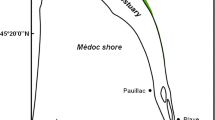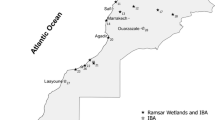Abstract
Although the conservation stakes of saltmarshes are widely documented, these areas are still subjected to strong anthropic pressures, including land reclamation, leading to their conversion into arable lands, and agricultural exploitation (mainly cattle grazing and mowing), which modifies their floral and faunal composition. Through the example of one of the largest French saltmarshes, we first assessed how the age of the saltmarsh patches and the mowing intensity determined the spatial distribution of the different saltmarsh habitats. We then tested how the five commonest breeding passerines were distributed in accordance with the mowing activity and the distribution of these habitats. We found that the oldest and the unmowed patches promote the development of habitats dominated by Elymus pungens and Atriplex portulacoides, and also host the highest abundance of four of the five bird species studied. In the current context of an intense artificialization of the littoral area, this study highlights the importance of maintaining the oldest and the least human-impacted patches of natural habitats to conserve their associated biodiversity.







Similar content being viewed by others
References
Adam P (1999) Saltmarsh ecology. Cambridge University Press, Cambridge
Adam P (2002) Saltmarshes in a time of change. Environ Conserv 29:39–61
Ali S, Ripley SD (1997) Handbook of the birds of India and Pakistan, vol 8, 2nd edn. Oxford University Press, New Delhi, pp 31–35
Bakker JP (1985) The impact of grazing on plant-communities, plant-populations and soil-conditions on salt marshes. Vegetatio 62:391–398
Barbier EB, Hacker S, Kennedy C, Koch EW, Stier AC, Silliman BR (2011) The value of estuarine and coastal ecosystem services. Ecol Monogr 81:169–193
Baron-Yellès N, Goeldner-Gianella L (2001) Les Marais maritimes d’Europe atlantique. Presses Universitaires de France, Paris
Bibby CJ, Burgess ND, Hill DA, Mustoe SH (2000) Bird census techniques, 2nd edn. Academic Press, London
Bilodeau C (2010) Apport du Lidar à l’étude de la végétation des marais salés de la baie du Mont-Saint-Michel. Thèse de doctorat, Université de Paris-Est, Paris
BirdLife International (2013) The BirdLife checklist of the birds of the world, with conservation status and taxonomic sources. Version 6. http://www.birdlife.org/datazone/userfiles/file/Species/Taxonomy/BirdLife_Checklist_Version_6.zip
Boorman L (2003) Saltmarsh review. An overview of coastal saltmarshes, their dynamic and sensitivity characteristics for conservation and management. JNCC Report 334
Brickle NW, Peach WJ (2004) The breeding ecology of Reed Buntings Emberiza schoeniclus in farmland and wetland habitats in lowland England. Ibis 146:69–77
Brown AF, Atkinson PW (1996) Habitat associations of coastal wintering passerines. Bird Study 43:188–200
Buchsbaum RN, Deegan LA, Horowitz J, Garritt RH, Giblin AE, Ludlam JP, Shull DH (2009) Effects of regular salt marsh haying on marsh plants, algae, invertebrates and birds at Plum Island Sound, Massachusetts. Wetl Ecol Manag 17:469–487
Burger J, Shisler J, Lesser FH (1977) Avian utilisation on six saltmarshes in New Jersey. Biol Conserv 18:187–211
Cadwalladr DA, Owen M, Morley JV, Cook RS (1972) Widgeon (Anas penelope L.) conservation and salting pasture management at Bridgwater Bay National Nature Reserve, Somerset. J Appl Ecol 9:417–425
Chevan A, Sutherland M (1991) Hierarchical partitioning. American Statistical Association, Boston, pp 90–96
Costa MJ, Costa JL, Almeida PR, Assis C (1994) Do eel grass beds and salt marshes act as preferential nurseries and spawning grounds for fish? An example of the Mira estuary, Portugal. Ecol Eng 3:187–195
Costa MJ, Lopes MT, Domingos IM, Almeida PR, Costa JL (1995) Portuguese Fauna Working Group—Tagus and Mira sites. In: Lefeuvre JC (ed) The effects of environmental change on European saltmarshes: structure, functioning and exchange potentialities with marine coastal waters, vol 3. University of Rennes, Rennes, pp 95–174
Daiber FC (1977) Saltmarsh animals: distributions relating to tidal flooding salinity and vegetation. In: Chapman VJ (ed) Wet coastal ecosystems. Elsevier, Amsterdam, pp 79–108
Deceuninck B, Quaintenne G, Ward A, Dronneau C, Mahéo R (2014) Synthèse des dénombrements d’anatidés et foulques hivernant en France à la mi-janvier 2013. Ligue pour la Protection des Oiseaux. BirdLife International
Descender K, Maelfait JP (1999) Diversity and conservation of terrestrial arthropods in tidal marshes along the River Schelde: a gradient analysis. Biol Conserv 87:221–229
Donald PF, Evans AD, Buckingham DL, Muirhead LB, Wilson JD (2001) Factors affecting the territory distribution of Skylarks Alauda arvensis breeding on lowland farmland. Bird Study 48:271–278
Doody JP (1984) Threats and decline—Great Britain and Ireland. In: Dijkema KS (ed) Salt marshes in Europe. European Committee for the Conservation of Nature and Natural Resources, Strasbourg, pp 162–166
Elschot K, Bouma TJ, Temmerman S, Bakker JP (2013) Effects of long-term grazing on sediment deposition and salt-marsh accretion rates. Estuar Coast Shelf Sci 133:109–115
Esselink P, Fresco LFM, Dijkema KS (2002) Vegetation change in a man-made salt marsh affected by a reduction in both grazing and drainage. Appl Veg Sci 5:17–32
Ford H, Rousk J, Garbutt A, Jones L, Jones DL (2013) Grazing effects on microbial community composition, growth and nutrient cycling in salt marsh and sand dune grasslands. Biol Fertil Soils 49:89–98
Géhu JM (1975) Approche phytosociologique synthétique de la végétation des vases salées du littoral atlantique français. In Colloque phytosociologique, IV, La végétation des vases salées, Lille, Éd. Cramer, p 395–462
Géhu JM (1979) Etude phyto-coenologique analytique et globale de l’ensemble des vases et prés salés et saumâtres de la façade atlantique française. Rapport pour le ministère de l’environnement et du cadre de vie
Georges A, Fouillet P, Pétillon J (2011) Changes in salt-marsh carabid assemblages after an invasion by the native grass Elymus athericus Kerguelen. Zookeys 100:407–419
Geslin T, Lefeuvre JC, Le Pajolec Y, Questiau S, Eybert MC (2002) Salt exploitation and landscape structure in a breeding population of the threatened Bluethroat (Luscinia svecica) in salt-pans in western France. Biol Conserv 107:283–289
Geslin T, Eybert MC, Radureau A (2006) Influence of natural and anthropic perturbations on the distribution of salt marsh breeding birds in the Mont Saint-Michel Bay. Cah Biol Mar 47:23–30
Gilroy JJ, Anderson GQA, Grice PV, Vickery JA, Watts PN, Sutherland WJ (2009) Foraging habitat selection, diet and nestling condition in Yellow Wagtails Motacilla flava breeding on arable farmland. Bird Study 56:221–232
Gilroy JJ, Anderson GQA, Grice PV, Vickery JA, Sutherland WJ (2010) Mid-season shifts in the habitat associations of Yellow Wagtails Motacilla flava breeding in arable farmland. Ibis 152:90–104
Godet L, Pourinet L, Joyeux E, Verger F (2015) Dynamique spatiale et usage des schorres de l’Anse de l’Aiguillon de 1705 à nos jours. Enjeux de conservation d’un patrimoine naturel littoral marin. Cybergeo Eur J Geogr. http://cybergeo.revues.org/26774
Goeldner-Gianella L (2000) L’Allemagne et ses polders. CTHS, Paris
Gray AJ (1976) The Ouse washes and the Wash. In: Collectif, Nature in Norfolk—a heritage in trust. Norwich, Jarrold, pp 123–129
Greenbaum A, Giblin A (2000) Difference in properties of salt marsh sediment between hayed and reference site. Biol Bull 1999:225–226
Greenhalgh ME (1975) The breeding birds in the Ribble estuary saltmarshes. Nat Lancas 5:11–19
Gruar D, Barritt D, Peach WJ (2006) Summer utilization of oilseed rape by reed buntings Emberiza schoeniclus and other farmland birds. Bird Study 53:47–54
Henderson IG, Critchley NR, Cooper J, Fowbert JA (2001) Breeding season responses of skylarks (Alauda arvensis) to vegetation structure in set-aside (fallow arable land). Ibis 143:317–321
Kiehl K, Esselink P, Gettner S, Bakker JP (1994) The impact of sheep grazing on net nitrogen mineralization rate in two temperate salt marshes. Plant Biol 3:553–560
Kragten S (2011) Shift in crop preference during the breeding season by Yellow Wagtails Motacilla flava flava on arable farms in The Netherlands. J Ornithol 152:751–757
Lafaille P, Lefeuvre JC, Feunteun E (2000) Impact of sheep grazing on juvenile sea bass, Dicentrarchus labrax L. in tidal salt marshes. Biol Conserv 96:271–277
Lafaille P, Pétillon J, Parlier E, Valéry L, Ysnel F, Radureau A, Feunteun E, Lefeuvre JC (2005) Does the invasive plant Elymus athericus modify fish diet in tidal salt marshes? Estuar Coast Shelf Sci 65:739–746
Lefeuvre JC (2000) La production végétale des zones humides. In: Fustec E, Lefeuvre JC (eds) Fonctions et valeurs des zones humides. Dunod Press, Saint Just la Pendue, pp 211–243
Lefeuvre JC, Mouton JP, Mauxion A (2009) L’Histoire de la baie du Mont-Saint-Michel et de son abbaye. Éd. Ouest France, Rennes
Levé F (2002) Inventaire floristique et cartographie de la végétation de la réserve naturelle de la baie de l’Aiguillon (Charente- Maritime) en vue de la gestion et de la protection de sa faune et de sa flore. Rapport de DESS, Université de Brest
Ludlam JP, Shull DH, Buchsbaum R (2002) Effects of haying on salt-marsh surface invertebrates. Biol Bull 203:250–251
Mac Nally R (2000) Regression and model building in conservation biology, biogeography and ecology: the distinction between and reconciliation of ‘predictive’ and ‘explanatory’ models. Biodivers Conserv 9:655–671
Meire P, Kuijken E (1988) Het land van Saeftinghe, slikken en schorren: ecologische betekenis van getijdegebieden langs de Schelde. Water 43(214):222
Moreira F (1999) Relationships between vegetation structure and breeding bird densities in fallow cereal steppes in Castro Verde, Portugal. Bird Study 46:309–318
Pétillon J, Ysnel F, Canard A, Lefeuvre JC (2005a) Impact of invasive plant (Elymus athericus) on the conservation value of tidal salt marshes in western France and implications for management: responses of spider populations. Biol Conserv 126:103–117
Pétillon J, Ysnel F, Lefeuvre JC, Canard A (2005b) Are salt marsh invasions by the grass Elymus athericus a threat for two dominant halophilic wolf spiders? J Arachnol 33:236–242
Prinet A (1998) Carte de végétation de la réserve naturelle de la baie de l’Aiguillon (Vendée). Rapport de DESS. Université de Strasbourg
Rahman ML, Tarrant S, McCollin D, Ollerton J (2012) Influence of habitat quality, landscape structure and food resources on breeding skylark (Alauda arvensis) territory distribution on restored landfill sites. Landsc Urban Plan 105:281–287
Réserve naturelle de la baie de l’Aiguillon (2013) Plan De Gestion de la Réserve Naturelle de la Baie de l’Aiguillon. Sainte-Radégonde-des-Noyers
Sharps E, Smart J, Skov MW, Garbutt A, Hiddink JG (2015) Light grazing of saltmarshes is a direct cause of nest failure in Common Redshank Tringa tetanus. Ibis 157:239–249
Surmacki A (2004) Habitat use by Reed Bunting Emberiza schoeniclus in an intensively used farmland in Western Poland. Ornis Fennica 81:137–143
Tessier M, Vivier JP, Ouin A, Gloaguen JC, Lefeuvre JC (2003) Vegetation dynamics and plant species interactions under grazed and ungrazed conditions in a western European salt marsh. Acta Oecol Int J Ecol 24:103–111
Valéry L, Bouchard V, Lefeuvre JC (2004) Impact of the invasive native species Elymus athericus on carbon pools in a salt marsh. Wetlands 24:268–276
Verger F (1968) Les marais des côtes françaises de l’atlantique et de la manche et leurs marges maritimes. Etude de géomorphologie littorale, Thèse pour le doctorat ès lettres, Editions Broché
Verger F (2009) Zones humides du littoral français: Estuaires, deltas, marais et lagunes. Belin, Paris, pp 249–291
Vickery JA, Tallowin JR, Feber RE, Asteraki EJ, Atkinson PW, Fuller RJ, Brown VK (2001) The management of lowland neutral grasslands in Britain: effects of agricultural practices on birds and their food resources. J Appl Ecol 38:647–664
Vivier JP (1997) Disponibilité de l’azote dans un marais salé pâturé en baie du Mont Saint-Michel: Conséquences sur les échanges de matière organique. Ph.D., University of Rennes, Rennes
Walsh CJ, Papas PJ, Crowther D, Sim PT, Yoo J (2004) Stormwater drainage pipes as a threat to a stream-dwelling amphipod of conservation significance, Austrogammarus australis, in southeastern Australia. Biodiv Cons 13:781–793
Williams L, Noblitt GS IV, Buchsbaum R (2001) The effects of salt marsh haying on benthic algal biomass. Biol Bull 201:287–288
Wilson JD, Evans J, Browne SJ, King JR (1997) Territory distribution and breeding success of Skylarks Alauda arvensis on organic and intensive farmland in southern England. J Appl Ecol 34:1462–1478
Author information
Authors and Affiliations
Corresponding author
Appendix
Appendix

Rights and permissions
About this article
Cite this article
Guetté, A., Joyeux, E., Corre, F. et al. Old and unmowed saltmarsh patches provide attractive habitats for breeding passerines. Wetlands Ecol Manage 24, 477–493 (2016). https://doi.org/10.1007/s11273-015-9473-8
Received:
Accepted:
Published:
Issue Date:
DOI: https://doi.org/10.1007/s11273-015-9473-8




